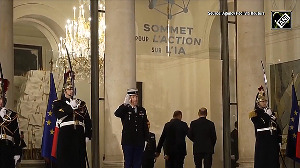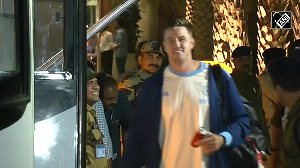What can you say about an industry that's been so steadily on an incline, there are no signs of packing up anywhere in sight? Of an industry where everything will be defined by more - more money, more sales, more artists making mucho moolah, more of, in fact, much more?
No wonder, the hottest thing on the eve of the next five years is heated discussions on the raids carried out on the premises of gallery owners. There's predictably much teeth nashing about it, of course, and a great deal of uneasiness, but it's also opening up for dialogue such corporate obfuscations as "transparency" and "chain of ownership" - stuff artists had dismissed as petty commercialisation of art.
But notice how they're not complaining about art being termed an "industry". All that chuff about creativity is just so much nosh. Get down to it and there's only one way everyone's viewing it right now, and that's by way of the worth of a work, or an artist, or a collection.
What's driving the prices up a hysterical spiral? As anyone in the art biz will tell you, that's an easy one. For starters, there's India making good news internationally, and so NRIs/PIOs are buying into the feel-good mood, dropping a few dollars here on real estate, a few more there on art, what's the difference?
Then (although this is all hush-hush, so of course you didn't read it here) there's the ugly business of the art cartels pushing up prices of certain artists by paying huge prices upfront and in public view, thereby registering high richter disturbances on the art index. (Okay, here's a test: How much was Tyeb Mehta's bestseller evaluated at in 2005? Answer: In the region of Rs 7 crore (Rs 70 million). How much should his next canvas sell for? If you answered Rs 7 crore of thereabouts, you'd know how you've let public perception colour your reasoning. The right answer might well be closer to a half-crore.)
What's more, there are emerging nexuses not only between galleries but between gallerists and owners of works, between owners and artists, and so on.
Else, why shouldn't you be able to buy a Chittrovanu Mazumdar, or a G R Iranna, or a Jagannatha Panda, or a Manish Pushkale (all of them tomorrow's blue chips)? Because sweetie, the punters got there before you did and brought them outright, lock, stock and future paintings.
If the art market is hot now, it'll be hotter by 2010, and for all it's worth, here are my predictions for some of the changes you'll see circa 2010:
Art indexes will be commonplace in the financial press, so you'll know how much your Akbar Padamsee went up, or down, last week.
Finally, definitely, we will have art insurance, with art evaluators, and therefore perhaps better explanations for those spiralling prices.
Many of the art funds would have matured, and proved better than IT stock shares. Money will come pouring in to increasing art funds, and though they might slow down compared to the maiden funds, they'll be seen as stable earners.
The black segment of the economy is significant {Rs 600-800 crore (Rs 6-8 billion) of the business is in the organised sector, perhaps a tenth of the annual trading in art), but by 2010, significant progress would have been made to move towards a cheque economy (else, you'll have to forgo the gains of insurance, and pay huge tax on presumed capital gains).
-
M F Husain will have had his day, overtaken by the Progressives, almost all of them commanding higher returns than the current maharaja of modern art.
-
A number of the young BPO/KPO art investors would have turned serious collectors, and ownership in India would definitely be the hands of the under-40s.
-
The Big Money will continue to come from outside, and NRIs will claim ownership of most senior artists from India.
- Experimental works will increasingly be shown in the West and in Asian cities, but the works will have an Indian rather than a global identity.
-
The multiplicity of galleries will continue, but the arena will be cleared and there will be a handful of them that do good work. The gallery phenomenon will invade little India.
- Finally, someone, somewhere, will have the bright idea of starting up an Artists Association of India. Members will then address a memorandum to the FM asking him for all concessions due to an "industry".
- The "highest" price for a work on canvas? Alas, I'm no astrologer, but get used to the sound of Rs 30 crore.
- The highest escalation in prices among the seniors? I'm betting on Krishen Khanna.







 © 2025
© 2025